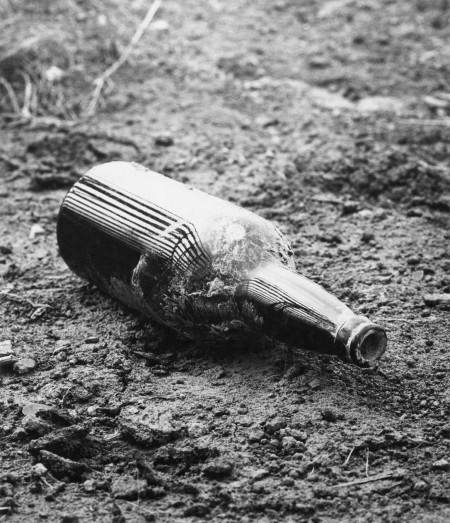In an undated and untitled photograph by Robert C. May, we are standing at the edge of some unremarkable woods, separated by a paved road from more woods on the other side. The view is dominated by four scruffy trees, no two of which are standing at quite the same angle. The road is as geometrical as the trees are freehand. The picture’s verticals and the horizontals are woven together with some formal elegance. On the road, some light-colored vehicle has just raced by, leaving only a blur behind it. The picture is about speed cutting its way through the slow growth of the forest, something man-made literally in the middle of all that nature, but the car is as much like a vapor trail as it is chrome and color and driver. The vehicle could be a ghost; it could have been our last chance to be rescued. I feel myself looking at it with yearning; this is what it’s like to be left by the side of the road. And yet I’m at home in those woods and frankly, I’m also glad it’s sped on.
The CAM’s show is about a regional art movement—the Lexington Camera Club—that did not want to think of itself as regional. The Club was founded in 1936, but the exhibit isn’t interested in its first couple of decades until 1954, when an optician named Ralph Eugene Meatyard joined up. He died in 1972 and the club disbanded in 1973. This is a show about Meatyard and his cultural moment. Meatyard was invigorated by and lent his energy and, ultimately, his leadership to a group of perhaps two dozen photographers, many of whom begin as hobbyists. Their interests and convictions about art were also informed by the presence of literary figures like Wendell Berry and Guy Davenport and haunted by the proximity of Thomas Merton. They do not dwell on their cultural isolation. Over the years, they made connections to Chicago and New York, and had significant contact with certain strains of the mainstream of mid-century American photography: Edward Weston was a teacher of Van Deren Coke, who also studied briefly with Minor White and Aaron Siskind, and who served as a mentor to Meatyard as his talent—and fame—developed.
They were conscious of the values and opportunities of the place where they found themselves. Lexington in the 1950s was a city in transition, with civic wealth and energy coming from tobacco and horse farms on the one hand and new industries, including a manufacturing branch of IBM, which provided Robert C. May with his day job. As a source of subject matter, Lexington had fewer factories than Detroit or Chicago, fewer crowds than New York, and more horses than Cincinnati. It had the remnants of agrarian elegance and industriousness and the skeleton of a bustling, early twentieth century city. We can appreciate some of this in Cranston Ritchie’s “Untitled [View down a Lexington street],” which is as welcoming of urban clutter as a Berenice Abbott view of New York, or Meatyard’s picture of a hardware store window, which feels like what Atget could have done on a visit to Lexington. (Is there anything in the world as crammed with unrelated metal things, as conducive to surrealistic still-life, as a hardware store?) Lexington had urban (and rural) decay, and African-American neighborhoods. In the mid-1950s, Coke and Meatyard worked together on a project documenting one of these neighborhoods, Davis Bottom. In general, this was a group of artists who strenuously resisted the picturesque. One gets the feeling that the memory of the WPA hung over them like an unacknowledged specter, in perpetual danger of swallowing their work and turning it into Americana.
We can watch the aesthetic battle against the partly documentary and partly sentimental impulses of a previous generation of documentary photographers in the sequence of works by the Club’s senior member, Van Deren Coke. (It is sometimes hard to make an argument about trends in any of these artists’ work since in addition to being scrupulously untitled, the photographs are very frequently scrupulously undated as well.) In “Waiting—Southern Railway Depot,” which feels like an earlier work, Coke seems sensitive to the implied story of a young man waiting for a train. Alone in the shadows of a cool corner of the waiting room, the man bends over, lost in thought or possibly prayer. He might be in extremis, and he might just be bored. I think we are being invited to both keep our distance and extend our sympathy. The Club members often traveled together to photograph the same places, and there is a remarkable pair of pictures taken at the Hillenmeyer plant nurseries, one by Coke and the other by Meatyard. Essentially a greenhouse with wooden slats instead of glass, the nursery presented a remarkable natural geometry of bright light and patterned shade. In Coke’s photograph, a man in overalls walks towards us carrying a basket on his shoulder. We look past the man to a long outdoor passage suggesting the scale of the Hillenmeyers’ operation. It seems to me that this could have been a WPA picture, the portrait of a man who works without shame or hesitation, a joint celebration of labor and capital.
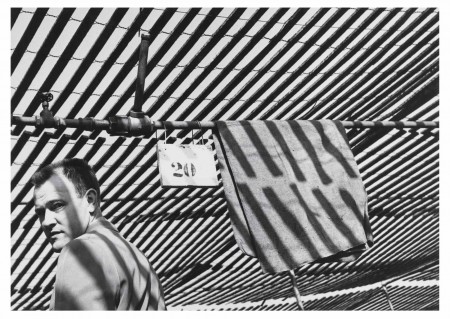
Meatyard’s picture at the same place could not be more different. The shadows of the slats are not symmetrical. They close off space rather than opening it up. The picture no longer seems designed to celebrate the ambition of the nurseries’ owner. The patterns of the slats’ shadows are interrupted by a cloth of some sort that hangs from a water pipe, and they fall as well across the face and back of a figure. The photograph has now turned into a portrait of some sort, although it is of a figure who is wearing a sport jacket, not overalls. He looks directly at the camera over his averted shoulder. The figure is not the worker, but Coke, Meatyard’s friend and mentor. The Coke photograph is about labor; Meatyards’s version is all about photography itself. It was clearly a part of the exhibition’s argument that in this pairing, we are watching the student surpassing and overwhelming his teacher.
Coke works to learn from the talent and vision of his student. In “Untitled [Two horses]”—which I would like to think of as a later work–Coke has taken a picturesque subject matter—horses eating outside a barn—and thrown away the elements of picturesque. On the right side of the picture, we see a horse’s head casting a shadow as it eats hay. On the left side, we see the heavy end of another horse presumably eating as well, though one half of each horse is hidden. Though still as severely symmetrical as the picture of the man working at a nursery, the image is of course fragmented (and perfectly witty). Do two half horses equal a whole one? The point of the horses is that they’re here to be photographed, not to do work. It feels as if this is the story the show wants to tell about what happens when a group of talented photographers work together with an extraordinarily talented one.
It seems fair to borrow a term Curator Brian Sholis applied to one of the Club members towards the group as a whole: their work is generally marked by an “absence of lyricism.” In place of sheer beauty and the appeal of narrative, these are photographers who share their interest in a set of fairly rigorous formal concerns. Sometimes their compositions are as centered and symmetrical as a target at a shooting range, or an iris and pupil returning our stare (such as we see in Cranston Ritchie’s “Untitled [Rock]”), and sometimes wildly unbalanced, such as James Baker Hall’s “Untitled” picture of two sheep who are practically falling out of the picture frame at the very edge of the lower right corner.
Untitled [Bottle], ca. 1956-61
Gelatin silver print, 8 x 7 5/8 in, (20.3 x 19.4 cm),
University of Louisville Libraries Special Collections
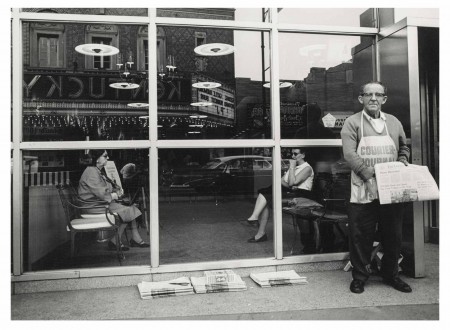
This layering of planes can be a wonderful and playful formal device even without the glass. Guy Mendes’s “Madison Place Porch, Lexington, KY” shows a whitewashed porch in vanishing point perspective with latticework on two sides and windows on a third. Occluding our view straight ahead is a pair of dark pants hung up with clothespins to dry on a delicate line. The porch is crisscrossed with other lines and clothespins, a series of potential flat planes ready to be created like a set of theater scrims ready to be slid into view. James Baker Hall’s “Untitled” presents a familiar version of the photographer’s self-portrait, the shadow of the picture-taker, here in coat and hat while out making pictures in the scrub woods. His silhouette is visible on two flat boards unevenly angled and spaced, so that his shadow is split into two parts, one taller than the other. In the space between the two boards, a white-faced cow stares back, more or less where the photographer’s head should be. The picture suggests an interplay between the looker and the looked-at, and a kind of playful and slightly eerie merger of the artist and his subject.
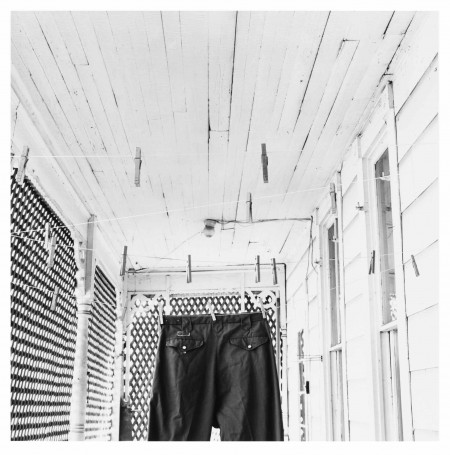
The wall text suggests how strongly the curator believes in the value of the exhibition’s section on Experimentation. The artists in the Club deliberately moved their cameras, took multiple exposures, played with focus and did a range of things to suggest movement in the still photo. I have to say that these pictures did not look as fresh to me as it did to the show’s curator. These are the years in which I was growing up and first taking notice of photography, but at the risk of sounding harsh, by the mid-1960s, these are the sorts of pictures I was editing in my high school yearbook. I admired Meatyard’s interest in what he called “no-focus” photographs (as opposed to “out-of-focus”), and some of the ways he moved his camera to draw with light are impressive. There is a very powerful photograph (“Untitled,” naturally) by Cranston Ritchie that looks like three richly-modulated brush strokes against a black backdrop. They are, I believe, curtains indoors taken with a camera panning downward on a tripod, but could be the high rises of some place and time in the future. Many of these experimental pictures are interested, as was their painterly contemporary movement Abstract Experessionism, in the sorts of marks you could create on a flattened picture plane. I wondered, though, if this experimentation is a sign of Lexington’s cosmopolitanism or its regionalism. They are allied to what was happening in New York, where a huge amount of pictorial energy was being released, but also seem at a great distance from it.
I found the People section to be the least revealing. (Meatyard’s best-known pictures are an extensive series of figures wearing dime-store masks, but those are very lightly represented in this show.) The street was not their muse. James Baker Hall has a haunting picture of his young son, “Matthew,” in a bathtub, with only his face out of the water and therefore sharply defined. The rest of his body and his flowing hair slips back into the obscuring bath, making him look like a water-spirit of some sort. It is fair to say that from this show, you would hardly know that women existed, either as artists or even as subjects. People of color fare just a little better. When all was said and done, this was a group that mostly took pictures of themselves, their children, and—especially—each other.
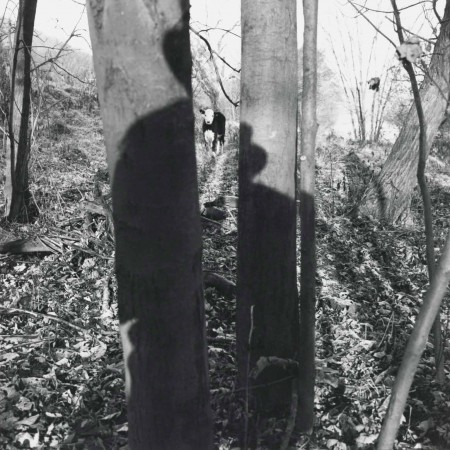
Untitled, ca. 1973,
Gelatin silver print, 6 11/16 x 6 11/16 in. (17 x 17 cm),
Cincinnati Art Museum: FotoFocus Art Purchase Fund, 2016.29
It’s hard to say why the figure does not emerge as a stronger subject. It’s the late 1950s and early 1960s and outside of Lexington, things are happening in figurative photography; this is the era of Robert Frank and Bruce Davidson and Diane Arbus and Garry Winogrand and Duane Michals. It feels to me like there was a fear of appearing parochial, of relying on regional appeal, of seeming quaint, of being southern. One of the most striking of the show’s figurative works is Charles Traub’s “Shelbyville, Kentucky,” which shows in one corner the elbow of a man planted on the table of a diner. There is salt and pepper on the table, and an overturned black ball cap in which we see a pair of sunglasses and a set of teeth. This seemed indebted to the work of Robert Frank, whose portraiture often defined people by the strange collections of things with which people surrounded themselves, rather than a soulful gaze into someone’s face.
While the works in the show are perfectly serious about eliminating anecdote from being a consideration in art, the same cannot said to be true about the catalogue or the wall text. Both contain an enormous amount of story. There are biographical details and accounts of their dealings with the others in the group and who met who and when. It was, as a colleague of mine wryly noted, after all, a club. At one end of a scale, the club’s members are truly interested in Merton, a spiritual presence in many of their works, whose physical absence inspired them to think about the non-literal content of their work. At another end of that scale, this is the story of a group of friends who worked together, and made much of each other’s company to the apparent exclusion of most other people—at least in their work. A subtext for a surprising number of works in the show is the romance, and perhaps even the eros, of friendship.
And while we are thinking about the implications of the word “club,” the show suggests that much of the charm and power of the artists comes from their implicit claim of amateurism. It may be hard to say just who was a successful professional photographer in the middle decades of the twentieth century, but initially, it wasn’t these folk. But the show also traces the story of the dream of most amateurs: starting with nothing but their work and their regular, informal gatherings, these are people who went on to own galleries, to show at other people’s galleries, to show in larger cities across the country and in museums, to become teachers of photography, and critics and editors at Aperture, and even museum curators. They were not doctrinaire or part of a school. But they were able to make the most of their friendships and mutual influences, which they carefully blended with their sense of independence.
“Kentucky Renaissance” is an excellent way to contextualize Meatyard, a figure well worth the trouble to contextualize, even though it doesn’t explicitly address the work for which he is best known. It is a little grueling to get through: there are about one hundred photographs, all about the same size, hung pretty much in a single line across three galleries. For all the attention to the textual worlds of Guy Davenport and Thomas Merton and Wendell Berry, we saw mostly the covers of their books illustrated by these photographers than having the chance to read or hear the writers’ own words, which might have given some variety and visual relief. These are among the questions I should have liked to raise with the show’s curator, and author of a very substantial essay in the show’s catalogue, Brian Sholis.
But we can’t ask Sholis, because unfortunately, Sholis has left the Museum, and has moved with his family to Toronto. I enjoyed the fresh sensibility he brought to photography at the CAM, and thought that last year’s “Eyes on the Street” was a remarkable show. He was easy to talk with, scholarly and modest, and had a great eye for big ideas. I am terribly sorry that this is his valedictory show, and I know that I will miss him.

